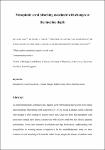Mesophotic coral bleaching associated with changes in thermocline depth
| dc.contributor.author | Diaz, C | |
| dc.contributor.author | Foster, N | |
| dc.contributor.author | Attrill, M | |
| dc.contributor.author | Bolton, A | |
| dc.contributor.author | Ganderton, P | |
| dc.contributor.author | Howell, K | |
| dc.contributor.author | Robinson, E | |
| dc.contributor.author | Hosegood, P | |
| dc.date.accessioned | 2023-10-05T10:01:06Z | |
| dc.date.available | 2023-10-05T10:01:06Z | |
| dc.date.issued | 2023-10-16 | |
| dc.identifier.issn | 2041-1723 | |
| dc.identifier.issn | 2041-1723 | |
| dc.identifier.other | 6528 | |
| dc.identifier.uri | https://pearl.plymouth.ac.uk/handle/10026.1/21355 | |
| dc.description.abstract |
As global temperatures continue to rise, shallow coral reef bleaching has become more intense and widespread. Mesophotic coral ecosystems (30–150 m) reside in deeper, cooler, water and were thought to offer a refuge to shallow-water reefs. Data now show that mesophotic coral ecosystems instead have limited connectivity with shallow corals but host diverse endemic communities. Given their extensive distribution and high biodiversity, understanding their susceptibility to warming oceans is imperative. In this multidisciplinary study we show evidence of coral bleaching at 90 m in the Indian Ocean, despite the absence of shallow-water bleaching. The bleaching was associated with sustained thermocline deepening driven by the Indian Ocean Dipole but further enhanced by internal waves whose influence varied at a subatoll scale. Our results demonstrate the potential vulnerability of mesophotic coral ecosystems to thermal stress and highlight the need for oceanographic knowledge to predict bleaching susceptibility and heterogeneity | |
| dc.format.extent | 6528- | |
| dc.format.medium | Electronic | |
| dc.language | en | |
| dc.publisher | Nature Research | |
| dc.subject | Animals | |
| dc.subject | Ecosystem | |
| dc.subject | Coral Bleaching | |
| dc.subject | Coral Reefs | |
| dc.subject | Anthozoa | |
| dc.subject | Water | |
| dc.title | Mesophotic coral bleaching associated with changes in thermocline depth | |
| dc.type | journal-article | |
| dc.type | Article | |
| plymouth.author-url | https://www.ncbi.nlm.nih.gov/pubmed/37845210 | |
| plymouth.issue | 1 | |
| plymouth.volume | 14 | |
| plymouth.publisher-url | http://dx.doi.org/10.1038/s41467-023-42279-2 | |
| plymouth.publication-status | Published online | |
| plymouth.journal | Nature Communications | |
| dc.identifier.doi | 10.1038/s41467-023-42279-2 | |
| plymouth.organisational-group | |Plymouth | |
| plymouth.organisational-group | |Plymouth|Research Groups | |
| plymouth.organisational-group | |Plymouth|PRIMaRE Publications | |
| plymouth.organisational-group | |Plymouth|Faculty of Science and Engineering | |
| plymouth.organisational-group | |Plymouth|Faculty of Science and Engineering|School of Biological and Marine Sciences | |
| plymouth.organisational-group | |Plymouth|Research Groups|Marine Institute | |
| plymouth.organisational-group | |Plymouth|REF 2021 Researchers by UoA | |
| plymouth.organisational-group | |Plymouth|Users by role | |
| plymouth.organisational-group | |Plymouth|Users by role|Academics | |
| plymouth.organisational-group | |Plymouth|REF 2021 Researchers by UoA|UoA07 Earth Systems and Environmental Sciences | |
| plymouth.organisational-group | |Plymouth|Users by role|Researchers in ResearchFish submission | |
| dc.publisher.place | England | |
| dcterms.dateAccepted | 2023-10-05 | |
| dc.date.updated | 2023-10-05T10:01:05Z | |
| dc.rights.embargodate | 2023-12-5 | |
| dc.identifier.eissn | 2041-1723 | |
| rioxxterms.versionofrecord | 10.1038/s41467-023-42279-2 |


